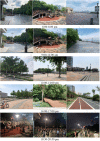Citizens' preferences and attitudes towards urban waterfront spaces: a case study of Qiantang riverside development
- PMID: 32803586
- PMCID: PMC7429094
- DOI: 10.1007/s11356-020-10419-6
Citizens' preferences and attitudes towards urban waterfront spaces: a case study of Qiantang riverside development
Abstract
Many cities are facing various environmental problems, where performance-based planning and nature-based solutions have been proposed to address such problems. As a natural landscape in the city, urban waterfront space has efficient ecological benefits, high-quality landscape vision and environment, and it is an important carrier of citizens' activities. However, existing studies have mainly focused on coping with environmental problems, while social functions and strategies have been neglected. Therefore, this study aims to fill such research gaps by understanding the social performance of urban waterfront spaces. Field observation and questionnaire survey were conducted in a famous urban waterfront space, Qiantang riverside walkway, in Hangzhou, China. The results indicate that the Qiantang riverside walkway serves as a space for tourism, leisure and entertainment, as the visitors who lived more than 5 km away from here accounted for about 50% and the local people also accounted for about 50%. People's activities exhibited significantly temporal differences, where the occupation of the Qiantang riverside walkway reached a peak at night. For the people who lived far from here, they mainly depended on self-driving, which led to two critical problems relevant to transport linkage with the city and parking lot. Results also indicate that the landscape, supporting facilities and road functions could perform well among the mind of 102 respondents. However, public service and main facilities should be improved to meet more people's requirements. Moreover, importantly, the results indicate the phenomenon of stratification and agglomeration so that the similar aspects (e.g. rest seat quantity, rest seat style) could be merged into the same cluster (e.g. rest seat) for consideration in the urban waterfront space planning and design. This study also generates some implications for the renovation of urban waterfront spaces. Overall, this study provides people with basic understanding of the social performance of existing urban waterfront spaces, which can further promote urban planners and designers to comprehensively build sustainable, resilient and healthy water-based living environments.
Keywords: Landscape; Main facilities; Preferences and attitudes; Public service; Qiantang River walkway; Road functions; Social performance; Stratification and agglomeration; Supporting facilities; Urban waterfront spaces.
Figures










Similar articles
-
How Do Ecological and Recreational Features of Waterfront Space Affect Its Vitality? Developing Coupling Coordination and Enhancing Waterfront Vitality.Int J Environ Res Public Health. 2023 Jan 10;20(2):1196. doi: 10.3390/ijerph20021196. Int J Environ Res Public Health. 2023. PMID: 36673952 Free PMC article.
-
Landscape Aesthetic Value of Waterfront Green Space Based on Space-Psychology-Behavior Dimension: A Case Study along Qiantang River (Hangzhou Section).Int J Environ Res Public Health. 2023 Feb 10;20(4):3115. doi: 10.3390/ijerph20043115. Int J Environ Res Public Health. 2023. PMID: 36833810 Free PMC article.
-
[The possibility of fulfilling the needs of senior individuals through the activation of waterfront areas using mobile architectural-urban elements].Med Pr. 2024 Jul 25;75(3):211-222. doi: 10.13075/mp.5893.01519. Epub 2024 Jul 1. Med Pr. 2024. PMID: 38949194 Polish.
-
The Role of Urban Morphology Design on Enhancing Physical Activity and Public Health.Int J Environ Res Public Health. 2020 Mar 31;17(7):2359. doi: 10.3390/ijerph17072359. Int J Environ Res Public Health. 2020. PMID: 32244358 Free PMC article. Review.
-
Urban and transport planning, environmental exposures and health-new concepts, methods and tools to improve health in cities.Environ Health. 2016 Mar 8;15 Suppl 1(Suppl 1):38. doi: 10.1186/s12940-016-0108-1. Environ Health. 2016. PMID: 26960529 Free PMC article. Review.
Cited by
-
How Do Ecological and Recreational Features of Waterfront Space Affect Its Vitality? Developing Coupling Coordination and Enhancing Waterfront Vitality.Int J Environ Res Public Health. 2023 Jan 10;20(2):1196. doi: 10.3390/ijerph20021196. Int J Environ Res Public Health. 2023. PMID: 36673952 Free PMC article.
-
Landscape Aesthetic Value of Waterfront Green Space Based on Space-Psychology-Behavior Dimension: A Case Study along Qiantang River (Hangzhou Section).Int J Environ Res Public Health. 2023 Feb 10;20(4):3115. doi: 10.3390/ijerph20043115. Int J Environ Res Public Health. 2023. PMID: 36833810 Free PMC article.
References
-
- Abhijith K, Kumar P, Gallagher J, McNabola A, Baldauf R, Pilla F, Broderick B, Di Sabatino S, Pulvirenti B. Air pollution abatement performances of green infrastructure in open road and built-up street canyon environments–A review. Atmos Environ. 2017;162:71–86. doi: 10.1016/j.atmosenv.2017.05.014. - DOI
-
- Argüeso D, Evans JP, Fita L, Bormann KJ. Temperature response to future urbanization and climate change. Clim Dyn. 2014;42:2183–2199. doi: 10.1007/s00382-013-1789-6. - DOI
-
- Baptiste AK, Foley C, Smardon R. Understanding urban neighborhood differences in willingness to implement green infrastructure measures: a case study of Syracuse, NY. Landsc Urban Plan. 2015;136:1–12. doi: 10.1016/j.landurbplan.2014.11.012. - DOI
-
- Binns T, Nel E. Tourism as a local development strategy in South Africa. Geogr J. 2002;168:235–247. doi: 10.1111/1475-4959.00051. - DOI
-
- Botequilha-Leitão A, Díaz-Varela ER. Performance based planning of complex urban social-ecological systems: the quest for sustainability through the promotion of resilience. Sustain Cities Soc. 2020;56:102089. doi: 10.1016/j.scs.2020.102089. - DOI
MeSH terms
LinkOut - more resources
Full Text Sources
Research Materials

